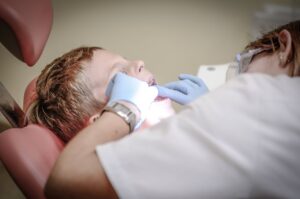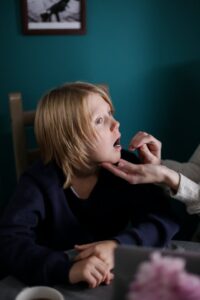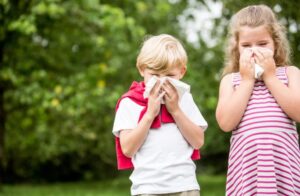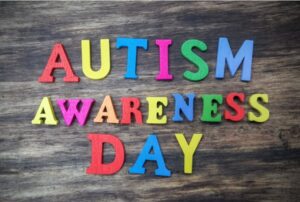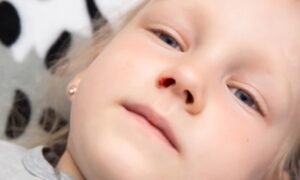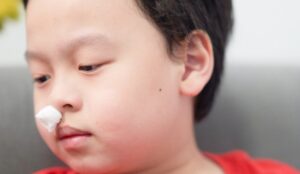Hand, foot, and mouth disease (HFMD) is a common infectious disease caused by enteroviruses, particularly affecting young children. While most affected children experience mild symptoms and recover on their own, understanding its symptoms, transmission routes, prevention measures, and treatment is crucial. This article will explain the details of HFMD and provide parents with the measures they should take to protect their children.
Common Symptoms of Hand, Foot, and Mouth Disease: How to Recognize and Diagnose?
Symptoms of HFMD typically appear 3-7 days after infection and include:
- Fever: Most children initially present with fever, typically ranging between 38-39°C.
- Oral Ulcers: Children may develop small white ulcers in the mouth, usually on the tongue, inner cheeks, or roof of the mouth, accompanied by pain.
- Rash: Small blisters may appear on the hands, feet, buttocks, and other parts of the body. These blisters are prone to rupture and form scabs.
Example: For instance, Ms. Li's son, Eason (3 years old), started to develop a fever while at kindergarten and had multiple ulcers in his mouth, making it painful for him to eat. After seeing a doctor, Eason was diagnosed with HFMD. The doctor advised Ms. Li to ensure Eason stays hydrated and isolates him at home to prevent spreading the virus to other children.
Transmission Routes of Hand, Foot, and Mouth Disease: How to Effectively Reduce the Risk of Spread?
HFMD is primarily transmitted through:
- Droplet Transmission: The virus spreads through droplets when an infected person coughs or sneezes.
- Contact Transmission: The virus can spread through the saliva, nasal mucus, and blister fluid of an infected person, especially in children through shared toys, utensils, and other objects.
- Airborne Transmission: Some viruses can also spread through the air, although this transmission route is rarer.
To reduce the risk of transmission, parents should take the following preventive measures:
- Frequent Handwashing: Children should develop the habit of washing their hands before meals, after using the toilet, and after returning home.
- Avoid Close Contact with Infected Individuals: If there is a sick child at home, isolate them as much as possible and avoid going to public places.
- Maintain Household Cleanliness: Regularly disinfect commonly touched items like toys, utensils, and door handles.
Complications of Hand, Foot, and Mouth Disease: When to Seek Medical Attention?
While most cases of HFMD are mild, some children may develop complications that require special attention:
- Dehydration: Oral ulcers can make it painful to eat or drink, leading to dehydration if the child refuses fluids.
- Viral Meningitis: Though rare, some children may experience persistent high fever, mental abnormalities, or other neurological symptoms.
- Cardiac Complications: A small number of children may develop heart complications, especially those with weakened immune systems.
Medical Advice: If the child’s fever persists for more than 3 days without subsiding, or if severe oral ulcers interfere with eating, parents should seek medical attention immediately to prevent the condition from worsening.
Prevention Measures for Hand, Foot, and Mouth Disease: How to Minimize the Risk of Infection?
- Maintain Good Hygiene: Teach children to wash their hands regularly, especially before meals, after using the toilet, and after returning home.
- Disinfect the Environment Regularly: Commonly used items such as toys, door handles, and remote controls should be disinfected regularly.
- Avoid Going Out While Infected: Children with HFMD should avoid attending gatherings or going to public places while they are infected to prevent the spread of the virus.
- Maintain a Proper Diet: During the illness, ensure the child stays hydrated and consumes light, easily digestible foods.
FAQs: Common Questions about Hand, Foot, and Mouth Disease
1. How long is the contagious period for hand, foot, and mouth disease?
The contagious period typically lasts from a few days before symptoms appear until the scabs from the rashes have healed. Children are most contagious during the early stage of the illness, when rashes appear, and after the blisters rupture. Therefore, infected children should avoid contact with other children during this period.
2. Does hand, foot, and mouth disease resolve on its own?
Yes, most children recover from HFMD on their own with mild symptoms, usually within 7-10 days with proper care and rest. However, if symptoms worsen or complications arise, medical attention is necessary.
3. Is there a vaccine to prevent hand, foot, and mouth disease?
Currently, there is no specific vaccine for HFMD. However, by enhancing the child's immune system, improving personal hygiene, and avoiding close contact with infected individuals, the risk of infection can be significantly reduced.
4. Can a child go to school if they have hand, foot, and mouth disease?
During the illness, children should avoid going to school, daycare, or other group environments to prevent spreading the virus. It is safest for the child to return to school or public places once their symptoms have disappeared and the rashes have scabbed over.
References:
- Centers for Disease Control and Prevention (CDC), "Hand, Foot, and Mouth Disease". CDC Official Website
- "China Children's Infectious Disease Diagnosis and Treatment Guidelines", Chapter on Clinical Manifestations and Treatment of Hand, Foot, and Mouth Disease.
- World Health Organization (WHO), "Hand, Foot, and Mouth Disease Overview". WHO Official Website
- National Health Service (NHS), "Hand, Foot, and Mouth Disease Information". NHS Website




